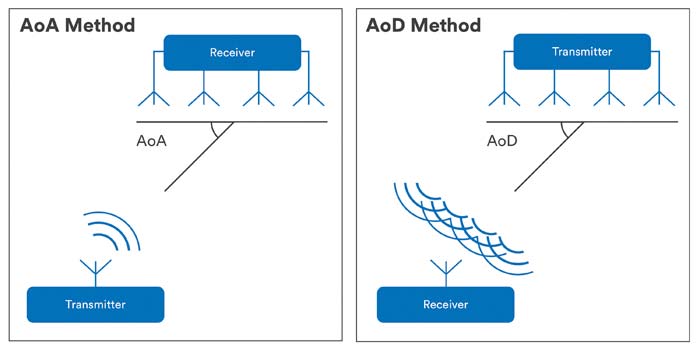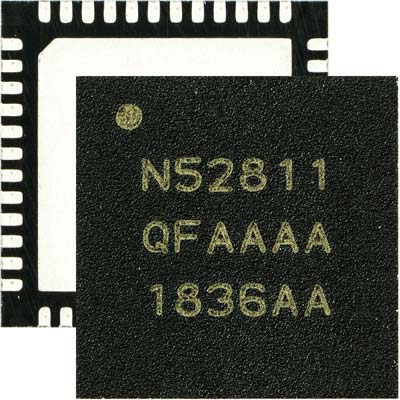![]() The Core Specification 5.1 for Bluetooth and the direction-finding function that it contains now allows for direction detection and improves location tracking accurate to just a few centimeters. Thanks to numerous improvements in automation scenarios and indoor location tracking services, Bluetooth will be a serious option for hard industrial applications in the future.
The Core Specification 5.1 for Bluetooth and the direction-finding function that it contains now allows for direction detection and improves location tracking accurate to just a few centimeters. Thanks to numerous improvements in automation scenarios and indoor location tracking services, Bluetooth will be a serious option for hard industrial applications in the future.
With the latest generation of Bluetooth Low Energy, Core Specification 5.1 (available here), the Bluetooth Special Interest Group (Bluetooth SIG) has paved the way for even more precise location tracking services based on the widespread Bluetooth standard. ABI Research expects up to 431 million products supporting Bluetooth location tracking services to be sold in 2023 [Bluetooth Market Update 2019].
In addition to the known distance tracking functionality using RSSI, the new Core Specification also offers a direction-finding function that allows the direction from which a signal is coming to be determined. This also allows for very precise position tracking, accurate to just a few centimeters, and offers a wide variety of new potential applications, both in the consumer segment and in industrial applications.
Proximity-Based Solutions and Positioning Systems
Bluetooth-based location tracking services may take the form of proximity-based solutions or positioning systems (Figure 1). The former are frequently applications that are used to approximate the distance between two Bluetooth devices within range of one another – often smartphones. Typical applications for proximity-based solutions already in use include point-of-interest solutions (POI), for example in retail or museums – when a visitor approaches a POI, they receive detailed information about the object being viewed. Many functions for everyday objects are also based on the proximity-based solution concept. In these applications a ‘beacon tag’ is placed on the object to be located (keychain, pallet, etc.) that can then be found using the smartphone.
 The second type, the positioning system, determines the location of individual objects in a closed system – a defined spatial area such as a warehouse, museum or airport lobby. The most common applications are real-time location systems (RTLS) and indoor positioning systems (IPS).
The second type, the positioning system, determines the location of individual objects in a closed system – a defined spatial area such as a warehouse, museum or airport lobby. The most common applications are real-time location systems (RTLS) and indoor positioning systems (IPS).
RTLSs enable multiple persons or objects equipped with appropriate tags to be tracked within a closed system. This makes it suitable for applications such as locating and tracking equipment, pallets or personnel in a warehouse.
![]() Indoor positioning systems are comparable to GPS, but unlike these, they also work in enclosed spaces. Permanently installed locator beacons regularly transmit signals that can be received by devices such as smartphones, which calculate their relative position based on the distance to the individual beacons. This allows passengers or visitors at airports or shopping malls to better find their way around.
Indoor positioning systems are comparable to GPS, but unlike these, they also work in enclosed spaces. Permanently installed locator beacons regularly transmit signals that can be received by devices such as smartphones, which calculate their relative position based on the distance to the individual beacons. This allows passengers or visitors at airports or shopping malls to better find their way around.
Previously, all Bluetooth-based location tracking systems were based on estimated distances calculated using the Received Signal Strength Indicator (RSSI). Using a reference value and the actual measured signal strength, the receiver calculates its distance from the beacon to just a few meters accuracy (~1m – 10m).
Antenna Mesh Enables Direction Finding
Direction finding is a new function in Bluetooth 5.1 that allows not only the distance of a signal but also the direction of its source to be determined. Traditional proximity-based solutions also benefit from this, as the direction of a signal is essential information that for example makes looking for an object much easier.
To determine the direction of a signal, either the receiver (angle of arrival, AoA) or the transmitter (angle of departure, AoD) of a location signal must have a permanently installed antenna mesh (Figure 2). In both versions, the receiver determines the direction from the signal is coming.
However, the direction-finding algorithms are not part of the Bluetooth 5.1 Core Specification. These can be determined by triangulating one or several angles measured using AoA or AoD along with the distance measured using RSSI. This allows location determination that is accurate to just a few centimeters.
AoA for tracking, AoD for navigation in enclosed spaces
In an AoA-based application the transmitter is a beacon with a single antenna, such as a smartphone or a simple tag. Multiple permanently installed receivers (locators), each equipped with a complex antenna mesh, determine the direction from which they receive the signal. AoA applications are especially well-suited to tracking objects (RTLS), such as in automated production or warehouses. They also enable enhanced accuracy when using beacons at points of interest.
AoD-based applications use antenna meshes on the transmitter of a beacon signal to send the signal via the different antennas in sequence. In this case the receiver – probably often a smartphone in the future – will have an antenna to receive the sequential signals. If the position of the beacons is known, the receiver can determine its position relative to the transmitters. This makes AoD-based applications especially well-suited to indoor positioning systems (IPS) for simple navigation in enclosed spaces such as airports. Unlike current IPSs, the user now receives not only their position, but also information about the direction of their destination. Unlike AoA-based applications, the AoD-based method is better suited to situations that rely on connectionless communication.
Design of the Antenna Meshes
Regardless of the method used, one of the most important success factors for the direction-finding function is the number and arrangement of the antennas. A series of antennas arranged simply in a row allows only the angle to be determined. More complex arrangements in three-dimensional space allow both horizontal and vertical angles to be determined. The Bluetooth SIG has not yet provided any specific requirements or recommendations regarding the arrangement of the antennas, although it is likely that this will change when more profiles on the new location-tracking services are published.
Bluetooth 5.1 has Great Potential
With the introduction of the latest-generation Core Specification 5.1 for Bluetooth and its direction-finding function, the Bluetooth SIG has taken a major step towards greater precision in location-tracking services, which may enable significant improvements in a variety of application scenarios. However, there are a number of aspects to be considered if this potential is to be leveraged. For example, an ideal application scenario must minimize reflections and multi-path interference. The ideal constellation is a closed system with enough permanently-installed locator beacons that have the tag in view at all times. For indoor navigation using smartphone to work throughout the entire area, Bluetooth 5.1 must be integrated into all readily-available smartphones. Polarization must also be taken into account when using smartphones, as its direction is almost impossible to control. The limited space in smartphones makes it likely that only one antenna will be available, even in the future, which is why smartphones will only be usable as transmitters in AoA-based applications or as receivers in AoD-based applications.
Nordic Semiconductor is one of the first manufacturers to offer a multi-protocol SoC (system on chip) with support for the new Bluetooth Core Specification 5.1. The nRF52833 supports not only Bluetooth Direction Finding and Bluetooth Long Range but also Bluetooth mesh, 802.15.4, Thread and Zigbee as well as proprietary 2.4 GHz protocols, allowing for applications involving distance measurements accurate to a matter of centimeters and direction information. The SoC is based on a 64 MHz ARM Cortex M4F processor with 512 KB flash memory and 128 KB RAM. Other features include full-speed 12 Mbps USB, high-speed 32 MHz SPI and +8 dBm output power. Its analog and digital interfaces include NFC-A, ADC, UART/SPI/TWI, PWM, I2S and PDM. Its supply voltage range is 1.7 V to 5.5 V. The nRF52833 is operable in an expanded temperature range of -40 °C and 105 °C.
Sources:
- Bluetooth 5.1 Core Specification Link
- Enhancing Bluetooth Location Services Link
- A Technical Look at Direction Finding Link
- Bluetooth Markt Update 2019, ABI Research Link
Autor: Heike Halder,
Product Manager
Wireless Competence Center
Rutronik | https://www.rutronik.com
![]()






